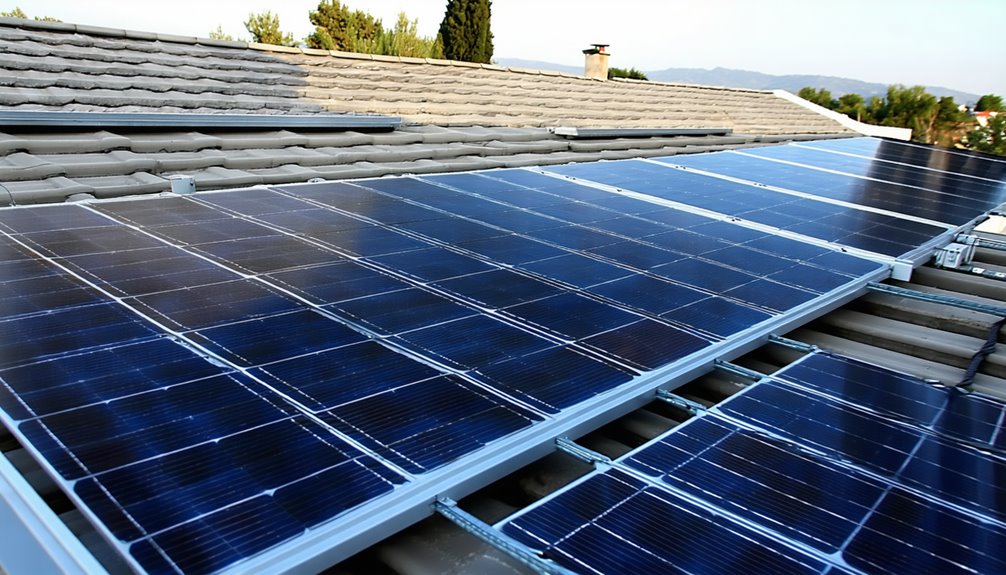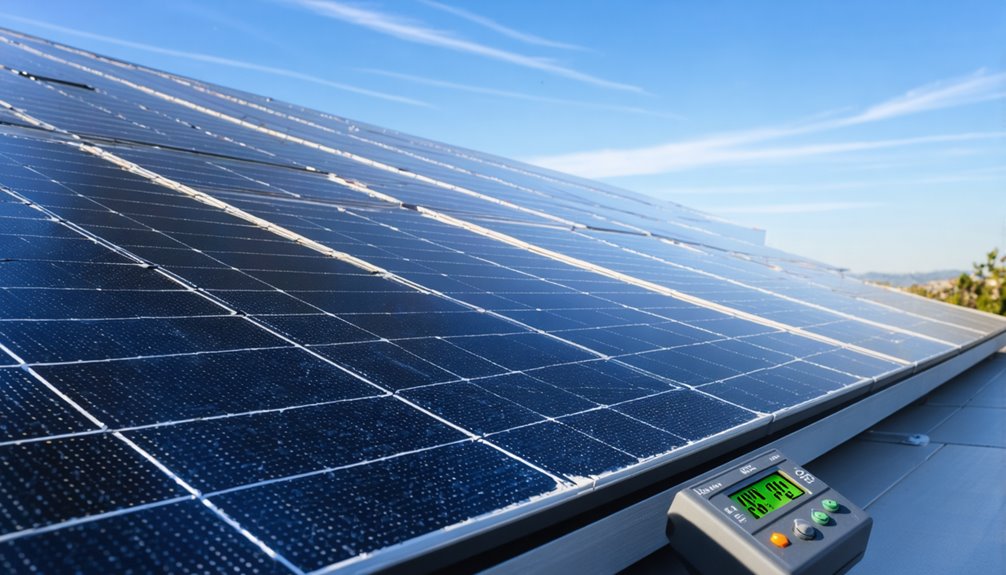You’re eyeing solar panels for your home, and efficiency tops your list to maximize energy output in limited space. Monocrystalline options shine with ratings up to 24%, promising higher yields than ever. But how do you pick the best models from brands like Maxeon or REC? Factors like your roof’s setup could change everything.
Key Takeaways
- Monocrystalline panels offer the highest efficiency for homes, averaging 21%-24%, outperforming polycrystalline and thin-film types.
- Top models include Maxeon’s SPR-MAX7-475 at 24% efficiency and JA Solar’s JAM54D40-460/LB at 23% efficiency.
- Real-world performance depends on shading, temperature, and orientation; use optimizers to mitigate losses.
- Conduct site assessments to ensure proper installation and maximize energy yield in limited spaces.
- High-efficiency panels cost more but provide long-term savings through increased output and shorter payback periods.
Understanding Solar Panel Efficiency Basics

When you’re evaluating home solar panels, you’ll first want to grasp efficiency basics: it measures how well panels convert sunlight into electricity, with residential models averaging 20% to 24% and advanced ones topping that.
You factor in elements like solar cell type, panel size, and design features that influence performance. For instance, certain cells deliver better results due to pure silicon and refined manufacturing, often exceeding 21%.
You’ll notice real-world efficiencies diverge from advertised ratings, impacted by shading, temperature, and installation orientation—these get tested under standard conditions (STC).
Consult a reliable solar panel supplier to assess how these variables affect your setup. Innovations like N-type cells and half-cell designs push boundaries, enhancing overall effectiveness compared to older models.
The future of global PV markets promises even higher efficiencies with trends forecasted through 2025.
Top Efficient Solar Panel Types for Homes
You seek the most efficient solar panel types to maximize your home’s energy output, and today’s top performers deliver impressive results. Monocrystalline panels stand out as the best choice for residential use, boasting efficiencies from 21% to 24% thanks to their high-purity silicon construction.
They convert sunlight into electricity more effectively, making them ideal if you’ve got limited roof space.
You’re also seeing exciting advancements in technologies like Heterojunction (HJT) and N-type cells, which push efficiencies toward 27% and beyond in the near future. These innovations mean you’ll generate more power from fewer panels.
With the IEA projecting a $450B solar investment in 2025, the push for even greater efficiencies in home solar panels is set to accelerate.
Opt for high-efficiency options, and you’ll slash your installation footprint—panels at 20% efficiency require just 30-50 square meters to cover a typical home’s needs, versus 40-70 square meters for 15% efficient ones.
This efficiency boosts your savings and energy independence.
Leading Manufacturers and Their High-Efficiency Models
You’ll find leading manufacturers like Maxeon, JA Solar, REC Group, VSUN, and Canadian Solar dominating the high-efficiency solar panel market for homes.
You’re looking at standout models such as Maxeon’s SPR-MAX7-475 with 24% efficiency and 475W output, JA Solar’s JAM54D40-460/LB at 23% and 460W, REC’s Alpha Pure-RX 470 at 22.6% and 470W, VSUN’s VSUN450N-96BMHR-DG-BB at 22.52% and 450W, or Canadian Solar’s TOPHiKu6 BoB at 22.5% and 460W.
As you compare their performances, you’ll notice how technologies like heterojunction and TOPCon boost energy generation and suit various residential needs.
Key Manufacturers Overview
Several leading manufacturers dominate the high-efficiency solar panel market, each offering standout models that push performance boundaries.
As you explore options for your home solar setup, you’ll discover Maxeon leading with its Maxeon 7 model, which delivers an impressive 24% efficiency and 445W power output.
You’ll appreciate JA Solar’s JAM54D40-460/LB, hitting 23% efficiency and 460W while using advanced half-cell technology to boost reliability.
Turn to REC Group’s Alpha Pure-RX 470 panels, where you get 22.6% efficiency and 470W output through heterojunction technology for better performance in various conditions.
You’ll also consider VSUN’s VSUN450N-96BMHR-DG-BB, offering 22.52% efficiency and 450W with innovative TOPCon tech.
Finally, Canadian Solar’s TOPHiKu6 BoB provides 22.5% efficiency and 460W, combining quality with affordability to suit your budget needs.
High-Efficiency Models
Leading manufacturers produce high-efficiency solar panels that push performance limits for your home setup.
You’ll find Maxeon at the forefront with its Maxeon 7 model, which delivers a stellar 24% efficiency and 445W output, maximizing energy harvest from limited roof space.
Aiko Solar’s Neostar 2P series impresses you with 24.3% efficiency and 485W power, positioning it as a powerhouse for high-performance needs.
Meanwhile, Longi’s Hi-MO X10 series aims for 24.7% efficiency by 2025, so you’re eyeing future-proof tech that advances rapidly.
Jinko Solar’s Tiger NEO series balances 23.8% efficiency with a robust 515W output, ensuring you get strong results.
Canadian Solar’s TOPHiKu6 offers 22.5% efficiency and 460W, combining quality and affordability for your budget-conscious installation.
Performance Comparisons
Maxeon leads with its Maxeon 7 solar panel, hitting 24% efficiency and 475W output to showcase cutting-edge technology. You’ll feel the thrill of powering your home with top-tier innovation.
You get strong value from JA Solar’s JAM54D40-460/LB model, delivering 23% efficiency and 460W through half-cell technology at a budget-friendly price—imagine the savings stacking up.
REC Group’s REC Alpha Pure-RX 470 excites with 22.6% efficiency and 470W, harnessing heterojunction tech for reliable, high-output energy that boosts your independence.
Don’t overlook VSUN’s VSUN450N-96BMHR-DG-BB, achieving 22.52% efficiency and 450W via TOPCon for optimized conversion.
Canadian Solar’s TOPHiKu6 BoB hits 22.5% efficiency and 460W, blending durability and affordability to empower your sustainable lifestyle.
Picture the pride in top performance—see how these stack up:
| Manufacturer | Empowering Edge |
|---|---|
| Maxeon | 24% efficiency, 475W—unleash ultimate savings and eco-victory! |
| JA Solar | 23% efficiency, 460W—affordable tech that transforms your bills! |
| REC Group | 22.6% efficiency, 470W—reliable power igniting your energy freedom! |
Factors Influencing Real-World Panel Performance
You notice that irradiance variations play a key role in your solar panels’ real-world performance, as sunlight intensity changes with your location, weather, and time of day, directly affecting energy output.
Shading from trees, buildings, or even dirt buildup can slash efficiency, so you must assess your site’s layout to position panels for maximum sun exposure.
Additionally, the choice of On-Grid Inverters can enhance system efficiency through grid synchronization and net metering support.
Irradiance Variations
Although solar panels get rated under standard test conditions with 1000W/m² irradiance, real-world variations from geographic location, seasonal weather, and factors like shading or sunlight angle often lower their actual output. You’ll notice that solar irradiance—the power of solar radiation per unit area—fluctuates based on where you live and the time of year, directly affecting your panels’ efficiency. In areas with frequent clouds or pollution, you might see output drop far below rated levels. Sunlight angle changes throughout the day also play a role, reducing performance when rays hit at oblique angles. To counter variable irradiance, you can use optimizers or microinverters—they let each panel perform at its peak despite inconsistencies.
| Region | Average Daily Irradiance (kWh/m²) |
|---|---|
| Southwest US | 5.5-6.5 |
| Northern Europe | 2.5-3.5 |
| Equatorial Africa | 5.0-6.0 |
| Southeast Asia | 4.0-5.0 |
Shading Impacts
Shading reduces solar panel output drastically, with even partial coverage from trees or buildings dropping efficiency by up to 50%.
You’ll notice that the position and density of these obstructions play a big role, so you must conduct thorough site assessments before installation to identify potential issues.
To counter shading, you can install optimizers or microinverters. These devices let individual panels operate at their best, avoiding the drag from the weakest one in a series setup.
Without them, your system’s real-world efficiency often falls short of rated values, as shading causes varying output reductions throughout the day.
You maximize energy yield by orienting panels properly and steering clear of shaded spots, ensuring ideal sun exposure for your home solar setup.
Comparing Efficiency Across Cell Technologies
When comparing efficiency across solar cell technologies, monocrystalline panels lead with ratings from 18% to over 24%, delivering the most power for your home setup.
You’ll get superior performance from these panels, as they convert more sunlight into electricity, maximizing your residential energy output.
In contrast, polycrystalline panels offer lower efficiency, typically 13% to 16%. They’re less commonly produced now, which means you’ll generate less energy overall compared to monocrystalline options.
Thin-film panels lag behind at 7% to 13% efficiency. Though they’re flexible and lightweight, you’ll find them more suitable for portable uses rather than your rooftop installation.
Look ahead to emerging technologies like perovskite cells; they’ve hit efficiencies near 27%, promising you future high-performance alternatives.
Advanced options, such as bifacial panels, capture sunlight from both sides, while heterojunction (HJT) cells optimize photon absorption, boosting your system’s efficiency greatly.
To maximize your home’s solar efficiency, consider selecting from Tier-1 solar panels offered by leading manufacturers for proven quality and reliability.
Balancing Cost, Size, and Efficiency in Selection
You select home solar panels by weighing efficiency against cost and size, building on how cell technologies like monocrystalline and advanced bifacial options boost performance.
Higher-efficiency monocrystalline panels, often exceeding 21%, cost more than polycrystalline ones, but they deliver greater value if your rooftop space is limited.
Consider models like Maxeon’s, which hit up to 24% efficiency; you’ll generate more energy in compact areas, optimizing your home’s layout.
Brands such as Aiko Solar and Longi use N-type monocrystalline cells to strike a smart balance, enhancing output without excessive expense.
Don’t overlook installation—proper setups minimize losses and can yield over 20% more energy than lower-efficiency alternatives.
Ultimately, you’ll save long-term as these panels produce more electricity, shortening your investment’s payback period.
Pairing efficient panels with hybrid solar inverters maximizes energy use by seamlessly integrating solar power, battery storage, and grid connectivity.
Conclusion
You’ve now explored the essentials of solar panel efficiency, from monocrystalline’s top 21-24% ratings to standout models by Maxeon, JA Solar, and REC Group delivering 460-475W. Remember, you optimize performance by evaluating your site, orienting panels wisely, and minimizing shade. Integrate hybrid inverters and batteries for smarter energy use. By balancing cost, size, and efficiency, you’ll select panels that maximize savings and sustainability—start your solar journey today and power your home smarter!


